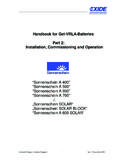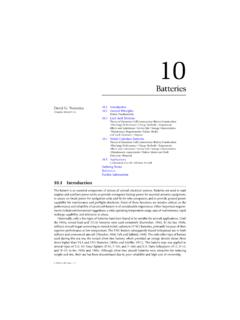Transcription of Handbook for Gel-VRLA-Batteries Part 1: Basic Principles ...
1 Industrial Energy, Technical Support - 1- Rev. 1, December 2003 Handbook for Gel-VRLA-Batteries part 1: Basic Principles , Design, Features Sonnenschein A 400 Sonnenschein A 500 Sonnenschein A 600 Sonnenschein A 700 ./. Sonnenschein SOLAR Sonnenschein SOLAR BLOCK Sonnenschein A 600 SOLAR Industrial Energy, Technical Support - 2- Rev. 1, December 2003 CONTENTS Handbook for Gel-VRLA-Batteries part 1: Basic Principles , Design, Features Page 1. History of SONNENSCHEIN and Gel- batteries 3 2. Function of vrla - batteries 4 Chemical Reactions 4 Gassing, Recombination 4 3. Design and Materials 8 Plate Construction and Alloys 9 Cell/Monobloc Containers 10 Terminal Posts 12 Valves 14 4.
2 Special Features of Gel- batteries 15 Capacity Range, Properties, Applications 15 Deep-Discharge 18 Heat Evolution and Dissipation 19 Acid Stratification 20 Industrial Energy, Technical Support - 3- Rev. 1, December 2003 1. HISTORY OF SONNENSCHEIN AND GEL- batteries 1910: Foundation of factory Akkumulatorenfabrik Sonnenschein in Berlin by Dr. Theodor Sonnenschein (former student of Max Planck); vented batteries (traction, automotive) 1926: Sonnenschein becomes OEM supplier to car industry 1938: New factory in Berlin 1946: New factory in B dingen Fig. 1: Factory B dingen/Germany 1957: Mr. Schwarz-Schilling became managing director and share holder 1957: Invention (by Otto Jache), patent and start of production dryfit Gel Technology; first vrla battery 1965: First dryfit licence contract with Globe Union (JCI) 1978: First dryfit Gel 2V cells 1987/88: New factory (Weiden/Germany) for Gel 2V cells 1991: Sonnenschein joined the CEAC group 1992: Shut down of Berlin plant ( termination of starter battery manufacturing) 1995: CEAC group bought by EXIDE (USA) 2000: EXIDE buys GNB Technologies (USA); new name: EXIDE Technologies Industrial Energy, Technical Support - 4- Rev.
3 1, December 2003 2. FUNCTION OF vrla -GEL- batteries Chemical Reactions The following formula shows the chemical reactions as a so-called overall reaction for discharge and charge: Pb + PbO2 + 2H2SO4 2 PbSO4 + 2H2O During discharge (reaction from left to right side), the lead of the negative electrode (active material) and the lead dioxide of the positive electrode are transformed into lead sulphate. The sulphuric acid is transformed into sulphate (lead sulphate) and water. The formation of water shows that the acid concentration is decreased. On the other hand, the acid is diluted by the formed water. During charge (reactions from right to left), these processes take place in the reverse direction. Gassing, Recombination A special feature of vrla - batteries consists in the recombination of oxygen during charge.
4 The cycle starts at the positive electrode: H2O O2 + 2H+ + 2 e- Water is decomposed and gaseous oxygen is formed. The hydrogen ions remain dissolved in the electrolyte and are not released as gas. The electrons move away via the positive electrode What is happening now with the oxygen? How does it make its way to the negative electrode? In lead-acid batteries of the vented design with free electrolyte, it is practically impossible for the oxygen to move to the negative electrode. Immediately after having left the positive electrode, it bubbles up and escapes through the vent plug. Discharge Charge Industrial Energy, Technical Support - 5- Rev. 1, December 2003 In vrla batteries , a densely porous medium is offered to the oxygen to facilitate its movement (AGM- batteries : pores in the glass mat; Gel- batteries : cracks in the gel).
5 Fig. 2 shows a comparison between vented and vrla - batteries . Fig. 2: Gassing and recombination in vented lead-acid and vrla batteries At the negative electrode, the following reactions take place: (1) Pb + O2 PbO (2) PbO + 2H+ + SO4 2- PbSO4 + H2O (3) PbSO4 + 2e- Pb + SO4 2- The oxygen oxidizes lead to lead oxide (formula (1)). This lead oxide is further transformed into lead sulphate with participation of hydrogen dissolved in the electrolyte and sulphate ions (formula (2)). This represents practically a discharge process. Further products of this reaction are water and heat, in addition to the ohmic losses during charging. Thus, the oxygen is recombined and water is re-converted. The circle is closed. The recombination efficiency in Gel- batteries is 95 %, typically 98%.
6 Industrial Energy, Technical Support - 6- Rev. 1, December 2003 The continuous flowing current during charge reconverts the lead sulphate into lead (formula (3)). One could say that in this way the negative electrode is constantly acting with a charging process and therefore cannot produce hydrogen. Otherwise, hydrogen would be produced which could not be reconverted because recombination of hydrogen does not happen. The hydrogen would be lost by diffusion through the cell container (gas permeability of the plastic material!) and through the valve respectively. The consequences would be increased loss of water. So the negative electrode is never fully charged. This is supported by over- dimensioning intentionally the negative active material. Naturally the hydrogen production cannot be fully suppressed due to electrochemical reasons.
7 Especially unfavorable operating conditions (high charging voltages and temperatures for instance) can provoke hydrogen production. Anyway, hydrogen is also generated in small amounts during corrosion of the positive plates. The oxygen produces a defined over-pressure within the cell. This is quite normal. The valve should not open at too low pressure because in that case too much oxygen would escape and get irretrievably lost. If the defined opening pressure is achieved (see chapter ), the valve opens for a short time and releases the accumulated gas. Under normal operating conditions this gas consists mainly of hydrogen. Under unfavorable conditions (high charge voltages at high temperatures, for instance) oxygen would also escape. The quantity of electrolyte is dimensioned in such a way that the battery attains the expected design life under normal operating conditions, taking into account - the rate of recombination, - the corrosion of the positive electrode (oxygen consumption!)
8 And - the losses by diffusion through the cell container. Gel- batteries have an electrolyte surplus anyway (see chapter ). Following amounts of gas were determined at Gel- batteries (table 1). Industrial Energy, Technical Support - 7- Rev. 1, December 2003 Charge conditions Measured [ml] Allowed [ml] A 400 Float Vpc 30 Over-charge Vpc 94 300 A 500 Float Vpc 5 30 Over-charge Vpc 90 300 A 600 Float Vpc 19 30 Float Vpc 30 Over-charge Vpc 300 300 A 700 Float Vpc < 20 30 Over-charge Vpc < 30 300 Table 1: Gassing acc. to IEC 896-2. Gassing rates measured per cell and per Ah within 30 days.
9 Gas consists of (approx.) 2/3 hydrogen and 1/3 oxygen. Over-charge voltage applied for tests only. Industrial Energy, Technical Support - 8- Rev. 1, December 2003 3. DESIGN AND MATERIALS Fig. 3: Design of a Gel-Valve-Regulated-Lead-Acid cell (Type OPzV) (Gel = with gelled electrolyte, is not visible in the picture. Other details are symbolical.) Industrial Energy, Technical Support - 9- Rev. 1, December 2003 Plate Construction and Alloys All negative plates are pasted and have common grid design. Alloy: Lead-Calcium (PbCa). The positive plates of all monobloc batteries have also pasted grids: Alloy: Lead-Tin-Calcium (PbSnCa). Gel-cells A 600 and A 600 SOLAR have positive tubular plates. Alloy: Lead-Tin-Calcium (PbSnCa). Calcium gives the grids mechanical stability and guarantees low gassing rates.
10 Tin is good for both, high corrosion resistance and high number of cycles. Highest numbers of cycles can be achieved with tubular plates as shown in fig. 4. Die-casting realizes a very fine grain structure of the spines. The gauntlet keeps the active positive material under high pressure avoiding loss of active material. b) Gauntlet and core, - front view a) Gauntlet and core (spine) c) Finished tubular plate Fig. 4: Design of a tubular plate used in A 600 and A 600 SOLAR Industrial Energy, Technical Support - 10- Rev. 1, December 2003 Cell/Monobloc Containers Three different kinds of material are used for containers and lids: PP (Polypropylene) ABS (Acrylonitrile-Butadiene Styrene Copolymer) SAN (Styrene-Acrylonitrile Copolymer) The materials are listed in tables 2 to 6 for the different battery types together with the UL-classification regarding flammability.






